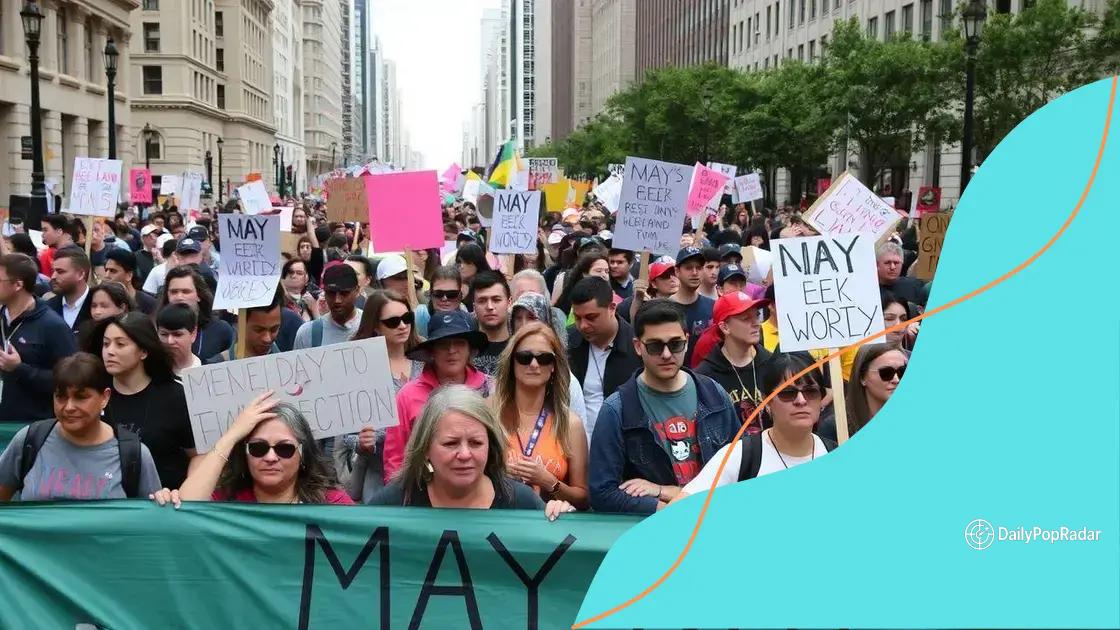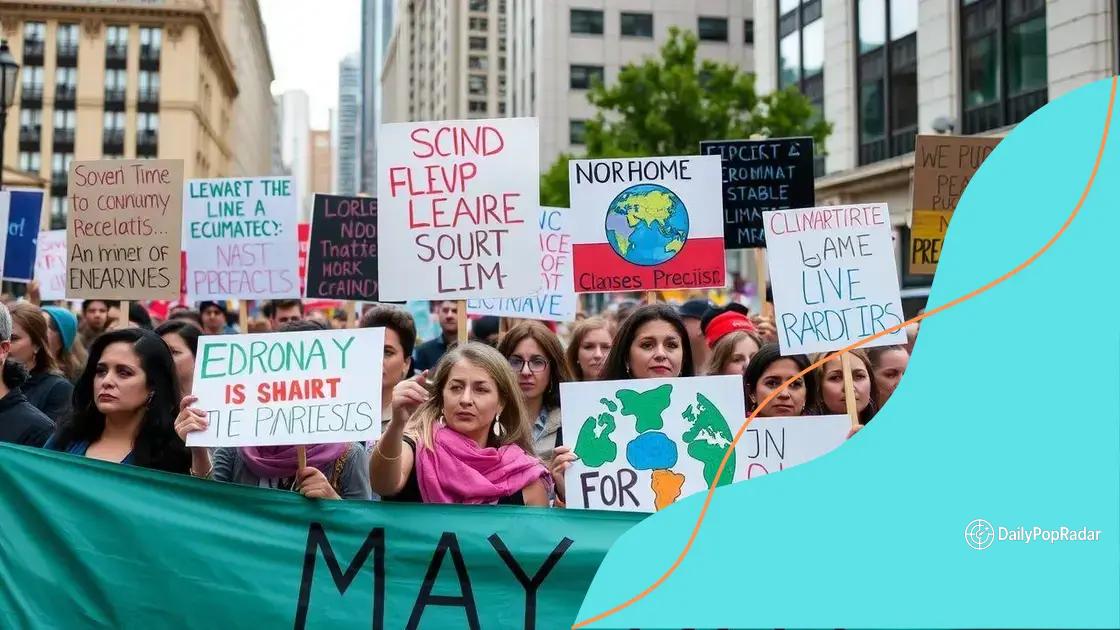May Day protests erupt across major cities

May Day protests highlight key issues such as fair wages, safe working conditions, and social justice, driven by global events and resulting in varied government responses that may shape the future of workers’ rights.
May Day protests erupt across major cities, capturing the attention of both supporters and critics alike. What drives so many people to take to the streets on this symbolic day? Let’s explore.
Understanding the origins of May Day protests
The origins of May Day protests trace back to the late 19th century, a time of significant labor unrest and social change. This day, celebrated on May 1st, became a symbol of workers’ rights and solidarity across the globe. As more people started to demand better working conditions, the spirit of May Day grew stronger.
Historical Context
Initially, May Day was tied to the celebration of spring. However, its transformation into a day of protest became apparent in 1886. Thousands of workers in Chicago organized a strike to push for an eight-hour workday. The protests were met with violence, leading to a tragic event known as the Haymarket Affair.
Key Events in May Day History
- The Haymarket Affair in 1886 ignited the labor movement.
- In 1890, the first official International Workers’ Day was celebrated.
- May Day protests have since spread worldwide, advocating for labor rights.
- Countries like France and Germany adopted May Day as a national holiday, further cementing its importance.
Today, May Day protests have become an enduring movement where workers rally to demand fair wages, safe working conditions, and social justice. Each year, a diverse mix of organizations and individuals takes to the streets, advocating for various causes that are relevant to the current political and economic climate. Cities across the world come alive with chants, music, and vibrant displays of solidarity among the working class.
As we reflect on the origins of these protests, it is essential to recognize that the fight for workers’ rights is far from over. The struggles seen today echo the voices that cried for change over a century ago. Workers continue to unite in solidarity, a testament to the enduring legacy of May Day.
Key issues raised by demonstrators this year
This year’s May Day protests have highlighted several key issues that resonate deeply within communities. Many demonstrators are voicing their concerns over working conditions, fair wages, and social justice. The focus on these issues illustrates a broader desire for change in various sectors.
Working Conditions
One of the primary concerns among protestors is the call for safe working conditions. Many workers, especially in essential industries, have faced unsafe environments, particularly during the pandemic. Activists are rallying for stricter regulations to protect workers’ health and safety.
Fair Wages
The demand for fair wages has become increasingly urgent. As inflation rises, many workers struggle to make ends meet. Demonstrators are advocating for a minimum wage increase to ensure that all individuals can have a decent standard of living. The push for fair compensation is a focal point at this year’s protests, with many calling for a living wage that reflects the costs of living.
Social Justice
Social justice remains a vital part of the conversation during these protests. Many participants are highlighting issues such as racial equality, gender rights, and inclusivity within the workplace. As workers unite to advocate for their rights, they are also standing in solidarity with those fighting against systemic inequalities. This intersectional approach has become a key feature of the demonstrations.
With these issues at the forefront, it is clear that the May Day protests continue to serve as a powerful platform for addressing the needs and aspirations of workers worldwide. The diverse voices coming together amplify the call for change, and they reflect a collective desire for a fairer and more just society.
Impact of global events on local protests

The impact of global events on local protests is profound. As each year unfolds, significant world events resonate through communities, influencing the issues that protesters choose to highlight. This year, for instance, various crises have shaped the narrative of the May Day protests.
Economic Factors
One of the main global events affecting local protests is the fluctuating economy. Economic instability, especially due to the pandemic, has resulted in job losses and reduced wages. As workers struggle to meet their basic needs, they turn to protests as a way to voice their frustration. Economic downturns spark demands for fair wages and job security, making them central topics at this year’s demonstrations.
Climate Change Awareness
Another significant issue influencing protests globally is climate change. As natural disasters become more frequent and severe, people are increasingly linking their fight for workers’ rights to environmental justice. Many demonstrators now advocate for jobs that not only provide livelihoods but also protect our planet. This unification of labor rights and climate action reflects a growing awareness among protestors.
Social Movements
The influence of social movements around the world cannot be overlooked. Movements advocating for racial equality, gender rights, and LGBTQ+ rights have inspired many local protests. Their message often intersects with labor-related issues, urging demonstrators to push for equality in all aspects of society. The solidarity shown through these connections enriches the dialogue within protests.
Overall, the impact of global events on local protests highlights how interconnected our struggles are. Demonstrators often find common ground in their goals while addressing both immediate concerns and broader societal challenges. The essence of May Day protests this year embodies the spirit of unity, not just within communities but across borders, as local actions echo the global fight for justice and equality.
Government responses to the protests
This year’s protests have prompted various government responses across different regions. As demonstrators voice their demands, governments must navigate the balance between maintaining order and listening to the concerns of their citizens.
Increased Police Presence
In many cities, one of the immediate responses has been an increased police presence during protests. While authorities argue that this is to ensure safety, it often raises tensions. Many protestors see this as a sign of government suppression rather than protection.
Dialogue with Activists
Some governments have taken a different approach, opting for dialogue with protest leaders. These discussions aim to address the issues being raised, such as fair wages and worker rights. This openness can foster a more peaceful resolution and demonstrate a willingness to listen.
Legislative Changes
In response to widespread protests, there have been instances of swift legislative changes. For example, some governments might propose new laws focused on labor rights or modifications to existing labor standards. These changes can reflect the impact of grassroots activism on policy.
However, responses can vary greatly between regions. In some areas, the government may choose to ignore the protests, while in others, they may publicly support the movements’ goals. This disparity can influence public perception and further fuel the protests.
Overall, the government responses to protests play a crucial role in shaping the outcomes of these events. As leaders react to the voices of their citizens, the effectiveness of their responses can either quell dissent or, conversely, spark further action from demonstrators seeking change.
Future implications for workers’ rights
The future implications for workers’ rights are closely intertwined with the ongoing movements and protests we see today. As more people unite to demand change, we can expect a shift in how workers’ rights are perceived and protected.
Evolving Labor Legislation
One of the most significant changes could be in labor legislation. Governments may start introducing new laws that better protect worker rights, addressing needs such as safe working conditions, fair pay, and job security. The current wave of protests highlights the urgency for these legislations, and lawmakers may feel pressured to respond quickly.
Increased Unionization
Another implication is the potential for increased unionization. As more workers recognize the power of collective bargaining, we might see a rise in union memberships. Unions can play a crucial role in advocating for worker rights, pushing for better contracts, and ensuring that employers adhere to labor laws.
Global Solidarity
The trend of global solidarity among workers is also growing. As workers in one country rally for their rights, it can inspire solidarity movements in others. This interconnectedness can lead to synchronized protests across borders, amplifying the calls for change. The international labor movement is likely to strengthen, creating a united front that resonates worldwide.
With technology also playing a role, digital platforms can facilitate organizing efforts, allowing workers to connect and share their experiences more easily. Social media can spread awareness and mobilize support for various causes, making it a vital tool for future advocacy.
In summary, the direction of workers’ rights will continue to evolve as a result of ongoing activism. The actions taken today will shape the landscape of labor relations for generations to come, determining how rights are upheld and what future generations can expect regarding their workplaces.
In conclusion, the current landscape of workers’ rights is shaped by ongoing protests and global solidarity movements. As workers unite to amplify their voices, we can expect significant changes in labor laws and working conditions. The demand for fair wages, safe working environments, and social justice are more relevant than ever. Governments and organizations must listen to these calls for change, leading to a fairer and more just future for all workers. The activism we see today will pave the way for a stronger labor movement, emphasizing the importance of collective action in securing rights for future generations.
FAQ – Frequently Asked Questions about Workers’ Rights Protests
What are the main issues discussed in this year’s protests?
The main issues include fair wages, safe working conditions, and social justice, all of which are highlighted by demonstrators.
How do global events influence local protests?
Global events, such as economic downturns and climate change awareness, significantly shape the issues and strategies of local protests.
What role do governments play in responding to protests?
Governments may increase police presence, engage in dialogue with activists, or implement legislative changes in response to protest demands.
What implications do current protests have for the future of workers’ rights?
Current protests are likely to lead to stronger labor laws, increased unionization, and a unified global approach to advocating for workers’ rights.
